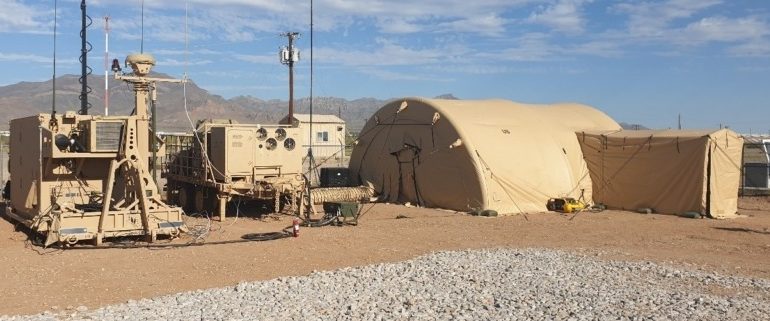[Huntsville Business Journal] When Secretary of the Army Ryan McCarthy visited Huntsville a few weeks ago, it was not to chop watercress.
One of his stops was to thank Northrop Grumman’s Huntsville team for its success in developing the Integrated Battle Command System, a weapons system that will give U.S. troops a technological advantage over the enemy, anywhere in the world.
“It’s not a question of whether or not we might get there,” he told more than 500 Northrup Grumman employees at IBCS manufacturing headquarters in Huntsville. “We have to get there.”
And get there they did – twice in fact over the past couple of weeks with two successful flight tests of the ICBS system.
Northrop Grumman developed IBCS with the Army as cornerstone of its integrated air and missile defense modernization program.
Primarily a Huntsville program, more than 500 of Northrop Grumman’s approximately 2,000 employees in the Huntsville area are involved in IBCS work, including Agile software development; the system’s overall design; and program management and foreign military sales. They also manufacture hardware at the Wall Triana facility, including the Engagement Operations Centers and Integrated Fire Control Network relays.
Furthermore, the Army’s IAMD Program office is at Redstone Arsenal.
The first of two planned operational IBCS flight tests, both were conducted at White Sands Missile Range by the Army 3rd Battalion, 43rd Air Defense Artillery Regiment.
Both were also part of the IBCS Limited User Test which is several tests simulating realistic battle operations and place performance stresses on the systems.
The first test’s defense included an Air and Missile Defense task force including two battery and one battalion engagement operations centers; two Patriot and Sentinel radars; and three Patriot Advanced Capability 3 launchers connected at the component level to the IBCS Integrated Fire Control Network.
The test began when two “enemy” cruise missile were launched and flew at a low altitude through a mountain range. IBCS fused real-time data from all sensors into a single, accurate composite track for each threat.
In response, two PAC-3 missiles controlled by IBCS were launched and intercepted the cruise missiles.
IBCS sensors extend the battle area, engage threats providing 360-degree protection, increasessurvivability by enabling early detection and continuous tracking, and deliver the capabilities to defeat an increasingly complex threat.
“We are extremely pleased with how IBCS performed during this flight test,” said Kenn Todorov, vice president and general manager, combat systems and mission readiness, Northrop Grumman. “We have been working on an extraordinary command and control system in partnership with the Army, and our goals are the same – to get this capability into the hands of the warfighter as soon as possible.”
The second IBCS test a few days later intercepted a high-performance, high-speed tactical ballistic missile ) target and a cruise missile target. It demonstrated the system’s ability to acquire, track, identify and engage diverse targets from various locations, speeds and altitudes.
Their defense consisted of two battery and one battalion IBCS engagement operations centers, two Patriot and two Sentinel radars, and four launchers with a mixture of PAC-2, PAC-3 and interceptors connected to the IBCS fire control network.
“I would like to recognize how exceptionally proud I am of the soldiers of the 3-43 ADA Battalion,” said Maj. Gen. Rob Rasch, Army Program Executive Officer, Missiles and Space. “This formation’s laser focus and steadfast dedication, starting with New Equipment Training last year through this LUT live fire, will ultimately transform the Air and Missile Defense fight for our joint formations.
“It’s been amazing to watch our soldiers’ ability to successfully track, engage, and destroy multiple targets in a highly-complex live fire operational test, further demonstrating the IAMD’s game-changing technological advantage. As we continue to fine-tune system performance in order to fully demonstrate system requirements in the Initial Operational Test & Evaluation in Fiscal Year 2022, we maintain high confidence for success due to the great leaders and soldiers of the 3-43, who will ultimately become the first-ever IBCS-enabled battalion.”
The flight test commenced with the target missiles being launched from different areas toward the Army defenders at the controls of IBCS. The tactical missile traveled on a ballistic trajectory, while the cruise missile surrogate flew a low-altitude course. Using data from the multiple radars and ICBS, the soldiers launched a PAC-2 to intercept the cruise missile and a PAC-3 to intercept the ballistic missile. Both targets were intercepted.
“These two back-to-back successful test events are a testament to the commitment and partnership between the great men and women of the Army’s operational and acquisition communities and Northrop Grumman’s program team,” said Todorov. “We are committed to the mission of the Army and look forward to continuing that partnership in getting the game-changing IBCS capability into production and fielded.”
Northrop Grumman employs a workforce of 90,000 worldwide.

